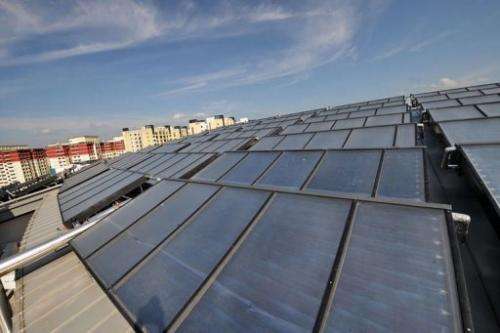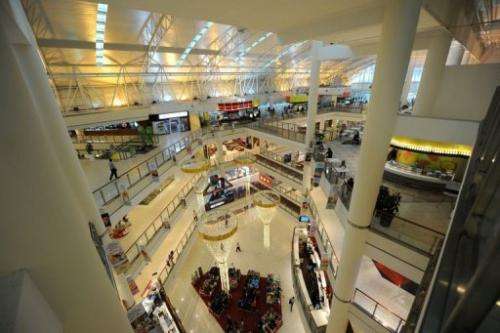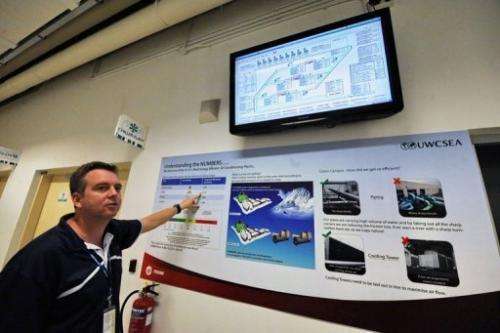Energy guzzler Singapore boosts 'green' buildings

From the bone-chilling air conditioning that pumps through Singapore's malls and offices to lights that burn all night, the city state is one of Asia's most intensive energy users.
Nearly all electricity used by the industrialised island is produced by burning fossil fuels, which in 2010 contributed to the largest carbon footprint per head in the Asia-Pacific region, according to conservation group the World Wide Fund for Nature (WWF).
South Korea and third-placed Japan follow close behind.
For environmentalists, the scenario is all too familiar in the Asia region whose urban population is set to soar from 1.9 billion to 3.3 billion by 2050 according to United Nations data.
Such growth puts sustainability on top of the agenda but critics say Asia's megacities are not doing enough to curb their voracious appetite for energy, with Singapore having been recognised as one of the worst offenders.
The WWF added that buildings contribute some 16 percent of Singapore's carbon emissions.
While the city-state contends that the WWF's per capita measurement of carbon emissions "disadvantages countries with small populations" -- compared to the likes of rapidly industrialising China -- it has nevertheless been spurred into action.

In 2005, the government embarked on a project to promote the development of high-tech, low-energy buildings and the retrofitting of older ones in a push to "green" at least 80 percent of all buildings by 2030.
Since then 1,000 government-certified green buildings have been built in Singapore, accounting for 13 percent of gross floor space in the country.
Along with cash incentives, developers who meet targets set by the Building and Construction Authority (BCA) are given more leeway to have bigger floor areas.
United World College Southeast Asia, an international school, is one of the torchbearers of the drive.
"Many new buildings are savagely overdesigned, wasting capital and upkeep costs. If you rationalise your design and spend on green technology, the savings are going to be immense," said Simon Thomas, its director of operations and facilities.
Features like rooftop solar panels, cascading walls that block off heat and optimal use of natural light make the campus about 30 percent more energy-efficient than conventional buildings of similar size, Thomas told AFP.
The college worked closely with architects to design a building that had energy efficiency as a central objective, he said.
The 2,500 students are also kept aware of daily water and electricity consumption levels, thanks to prominently displayed meters on every floor.
Its 5.5-hectare (13.5 acres) campus in Singapore's eastern region was awarded the nation's Green Mark Platinum award in 2011, the highest accolade in the official rating system.

Despite the surge in the development of such buildings, BCA chief executive John Keung said some developers are still averse to riding the green wave, due to what they see as relatively high costs of technologies such as solar.
"Although there are some who see great value in going green for their own corporate branding, others are discouraged by its perceived high upfront costs and low return on investments," Keung told AFP.
Developers who shun green technologies may not be fully aware of the scale of savings they are missing out on, according to Keung.
"The cost premium involved in green buildings is gradually decreasing with greater economies of scale and the industry's familiarity with green building design".
Despite the cost of solar panels falling by about four percent every year, solar-derived electricity remains more expensive than that from the power grid.
This is mainly due to its relatively high capital costs as well as maintenance costs, according to Singapore's Energy Market Authority.
City Developments Limited, one of Singapore's top property groups, is nevertheless confident that environmentally-friendly buildings will become the norm as "green consumerism" gains traction.
Its City Square Mall has an integrated park and solar-panelled roof. Some tenants sell eco-friendly products and offer discounts to customers who bring their own shopping bags.
With Singaporeans increasingly aware of environmental issues, there will be greater demand for investments in green innovations and technology, said Esther An, the company's head of corporate social responsibility.
In addition to making buildings more energy-efficient, Singapore is also aggressively developing desalination and sewage-recycling technology to address its chronic water shortages.
(c) 2012 AFP

















